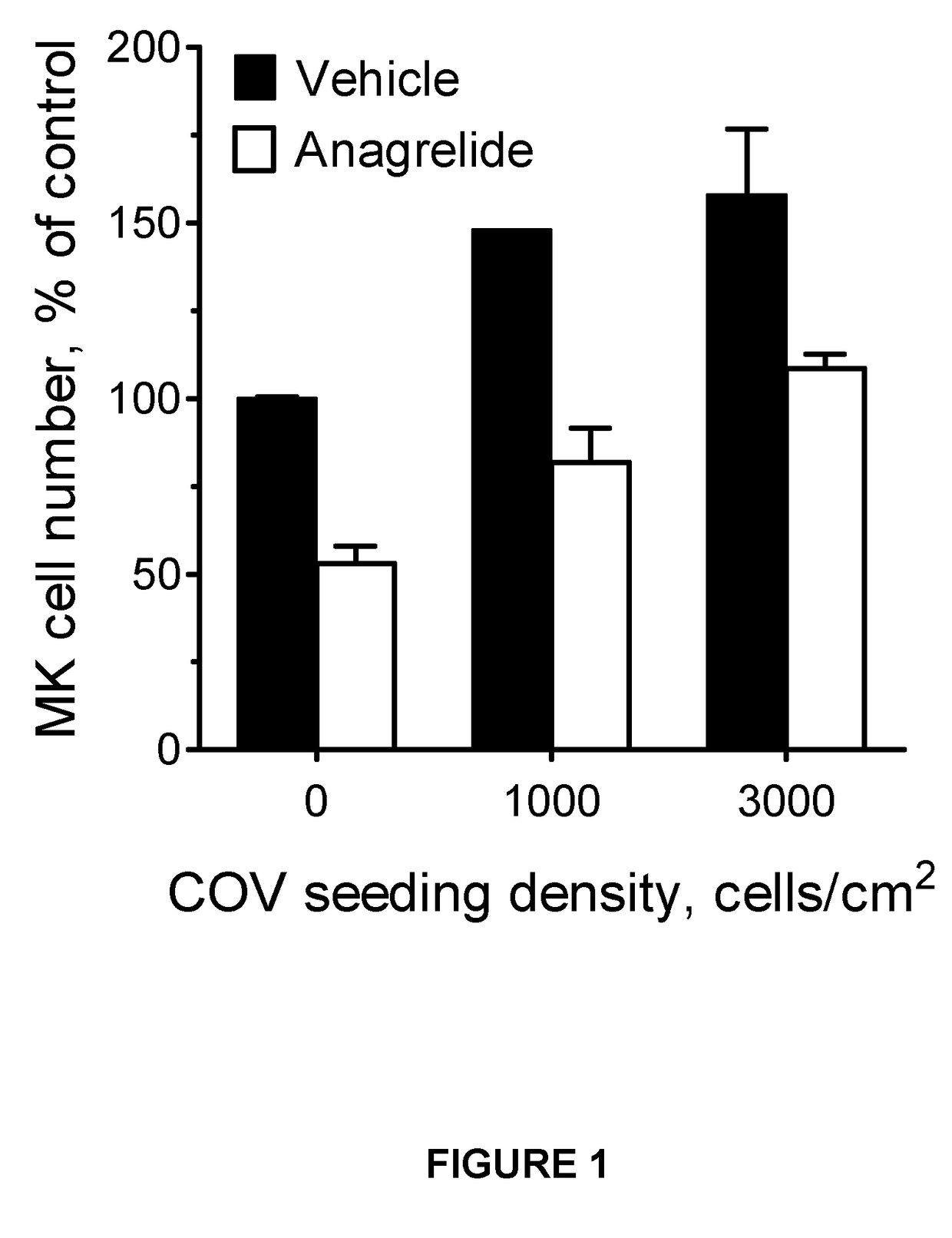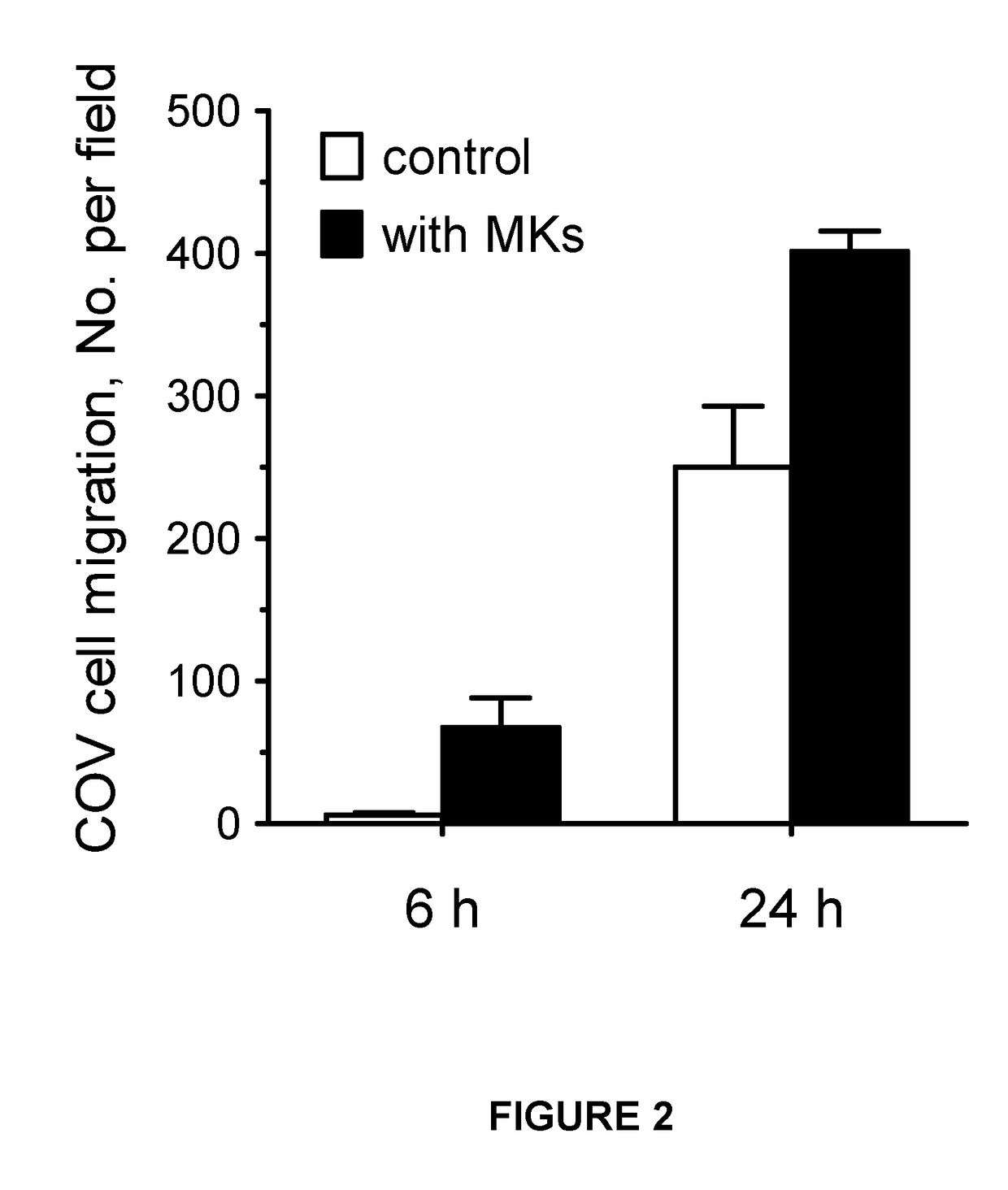Use of anagrelide for treating cancer
anagrelide and cancer technology, applied in the digestive system, blood disorder, non-active ingredients of pharmaceuticals, etc., can solve the problems of no drugs currently employed for this purpose, no cancer cycle or pathogenic loop established, etc., to reduce the chemotactic response of cancer cells and the potential for metastasis
- Summary
- Abstract
- Description
- Claims
- Application Information
AI Technical Summary
Benefits of technology
Problems solved by technology
Method used
Image
Examples
example 1
Demonstration of Anagrelide's Inhibitory Effects on Cancer Cell Mediated Megakaryocyte Expansion
[0200]Experimental Procedures:
[0201]Drugs—Anagrelide hydrochloride was purchased from Tocris Bioscience (Bristol, UK). A stock solution was made in DMSO, stored in aliquots at −20° C. and when required diluted in culture medium immediately before experiments.
[0202]Cells and drug treatment—Megakaryocytes (MKs) were generated ex-vivo essentially as previously described (Ahluwalia M et al 2010). In brief, to promote terminal megakaryocytic differentiation pre-expanded human umbilical cord blood-derived CD34+ haematopoietic cells were cultured for 7 days in Stemspan™ SFEM II medium (Stem Cell Technologies) supplemented with 1% human umbilical cord blood plasma and 40 ng / m1 thrombopoietin (TPO) unless otherwise indicated (MK medium). Where required, anagrelide (1 pM) or an equivalent amount of vehicle was added at the beginning of the differentiation period.
[0203]The human ovarian cancer cell ...
example 2
Demonstration of Anagrelide's Inhibitory Effects on Cancer Cell to Megakaryocyte Migration
[0209]Transmigration assay—Transmigration of human ovarian cancer cells, COV362 cells (COVs), was examined in a well established model of cancer cell migration (Hart et al 2005) and Kramer et al 2013) which employed the modified Boyden chamber described above but using inserts with a larger 8pm pore PET membrane. This pore size enabled cancer cells to move through to the under section of the chamber in response to any attract properties displayed by megakaryocytes beneath. In this case pre-expanded haematopoietic cells were grown for 7 days in MK medium in the wells of the companion plate prior to placement of the inserts. Inserts were then positioned inside these MK-containing wells or in parallel wells filled with and equivalent volume of MK medium alone. A suspension of 0.35 mL COVs cells made in plasma-free MK medium at a density of 2.86×105cells / mlwas then loaded onto the inserts and allow...
example 3
Demonstration of Anagrelide's Ability to Reduce Platelet Derived Cancer Cell Growth Factors Platelet Factor 4 and Vascular Endothelial Growth Factor (after Cacciola et al 2004)
[0212]Thirteen patients (eight men and five women mean age of 53 years) with essential thrombocythemia -ET (mean duration of disease 4 years) were recruited into this study. Four patients received hydroxyurea (HU)1.25 g / day, three patients interferon alpha (IFN-α) 1.5×106 units / day, and six anagrelide (A) 1.5 mg / day. Ten healthy subjects served as controls.
[0213]PF4 and VEGF were measured by an enzyme linked immunosorbent assay (Boehringer-Mannheim, Germany). Platelets were determined on a Sysmex XE-213000 (Dasit, Italy).
[0214]Before treatment all patients had a high platelet count 1045+ / −207×103 / μL and higher PF4 and VEGF (levels (137+ / −63 IU / mL and 1.5+ / −0.7 pg / mL than the controls 2.1+ / −1.5 IU / mL and 0.2+ / −0.08 pg / mL.
[0215]After treatment patients had a mean platelet count of 400+ / −62×103 / μL. Neither HU nor...
PUM
 Login to View More
Login to View More Abstract
Description
Claims
Application Information
 Login to View More
Login to View More - R&D
- Intellectual Property
- Life Sciences
- Materials
- Tech Scout
- Unparalleled Data Quality
- Higher Quality Content
- 60% Fewer Hallucinations
Browse by: Latest US Patents, China's latest patents, Technical Efficacy Thesaurus, Application Domain, Technology Topic, Popular Technical Reports.
© 2025 PatSnap. All rights reserved.Legal|Privacy policy|Modern Slavery Act Transparency Statement|Sitemap|About US| Contact US: help@patsnap.com



